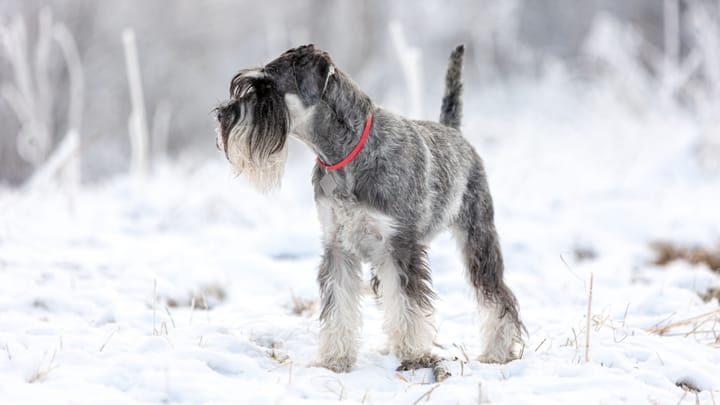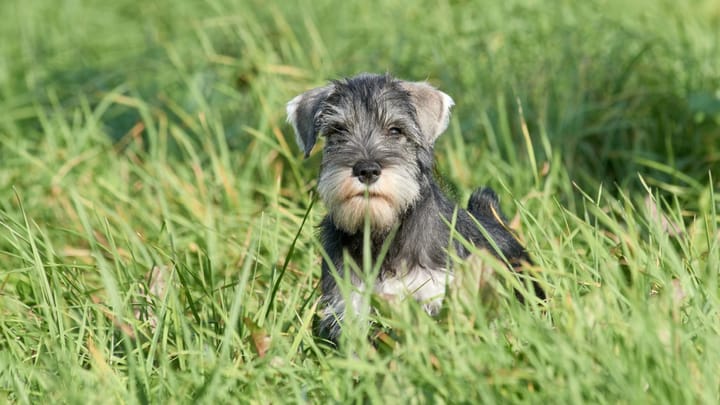Schnauzer
Other names : Miniature Schnauzer, Zwergschnauzer, Medium Schnauzer, Giant Schnauzer, Riesenschnauzer


Schnauzers are balanced dogs, though they also have strong personalities. They are very attached to their owners and family members. They feel very protective of children and are wary of strangers. There are three varieties: toy, standard, and giant. Schnauzers make good guard dogs because they are courageous and vigilant.
|
Life expectancy |
The Schnauzer has a life expectancy of between 12 and 14 years |
|
Temperament |
|
|
Size |
Large
|
|
Adult size |
Female
Between 18 and 20 in
Male
Between 18 and 20 in
|
|
Adult weight |
Female
Between 31 and 44 lb
Male
Between 31 and 44 lb
|
|
Coat colour
The medium and giant varieties can have a black, pepper or salt coat. The miniature Schnauzer can also have a black, pepper and salt coat as well as a black silver or pure white coat. |
Black Blue |
|
Type of coat
The hair is medium/long. The coat’s hair is hard (iron wire). This dog is well-coated and with a very dense undercoat. |
Long Hard |
|
Eye colour
They're dark. |
Brown
|
|
Purchase price |
The Schnauzer costs between £700 and £940 |
The name of the breed comes from the German word "schnauze" which means muzzle.
More details about the Schnauzer
Schnauzer: Origins and history
Their very ancient origins are common to those of Terriers, born for hunting, who are the ancestors of this dog. Then the selection of the breed was oriented towards the creation of a guard and defence dog. Towards the end of the fifteenth and early sixteenth centuries, a similar dog appeared on numerous places which was represented in the company of horses and stagecoaches. The other two breeds developed from the average breed. The CFI officially recognises the breed in 1955 and three different standards are written for the three varieties: Dwarf, Medium and Giant, although it is mainly their size that distinguishes them.
Physical characteristics of the Schnauzer
This dog exists in three sizes: medium, giant and dwarf. The three sizes have almost the same appearance. This dog is robust, strong and square-built. The head is sturdy, and elongated but his apophasis occipital is not very protruding. The stop is clearly delimited. The head-facing axes are parallel. The muzzle ends in a moderately truncated cone. The eyes are dark, oval in shape and arranged semi-laterally. The ears are located high and form a "V", with their tip folded. The extremities are straight and strong. The tail is tied up.
Schnauzer: Varieties
- Schnauzer (Medium)
- Riesenschnauzer (Giant)
- Zwergschnauzer (Dwarf)
Schnauzer: Characteristics
Schnauzer: Behaviour
Training a Schnauzer
These dogs are generally easy to educate if their masters are experienced. They may pose some problems to novice masters by being hard and stubborn: they only obey if they respect their master very much.
Education must be early and firm but without any brutality because this dog does not take well any unjustified reprimands.
Only a relationship based on respect and trust between the master and his dog makes it possible to obtain beautiful results with this breed.
Schnauzer: Lifestyle
Breed compatibility Schnauzer
Schnauzer: Purchase price
The price of a Schnauzer varies according to his origins, variety (medium, giant or dwarf), age and gender. An average of £940 is asked for a dog registered with KC. Generally, the giant is more expensive than the other two varieties: dwarf Schnauzer and medium Schnauzer.
The average budget to support a dog of this size is between £20 and £50 per month depending on the chosen variety (dwarf, Medium or Giant).
Schnauzer: Shedding
Average
Although he has an undercoat, his moulting periods are very moderate, or almost non-existent, especially if he is mowed and waxed regularly.
Schnauzer: Grooming
The maintenance of this dog takes time, especially to correspond to his breed’s standards during exhibitions for example. His haircut should be done by a canine grooming professional. Mowing and epilating on certain surfaces of the dog's body are necessary.
Otherwise, weekly brushings are recommended to maintain the beauty and protective qualities of his hard coat.
Schnauzer: Health
The lifespan is estimated at 13 years.
Rather rustic, this dog is quite sturdy and enjoys a good longevity, except the miniature Schnauzer which is more fragile.
Like many dogs, it is necessary to pay attention to heat strokes and to take care of him by offering a space in the shade and constant fresh water.
These dogs, including the dwarf, are well protected from the cold and can live both inside and outside.
If he is well fed and he enjoys daily walks to eliminate the accumulated calories, there is no reason for this dog to suffer from overweight.
However, attention must be payed to dogs that live in the city environment which only have simple neighbourhood walks!
In Riesenschnauzer (Giant Schnauzer):
- coxo-femoral dysplasia
In the middle Schnauzer:
- Coxo-femoral dysplasia
- Cataract
In the Zwergschnauzer (miniature Schnauzer):
- Legg-Perthes-Calvé (bone necrosis) disease
- Porto-Systemic Shunt (blood does not get to the liver properly)





